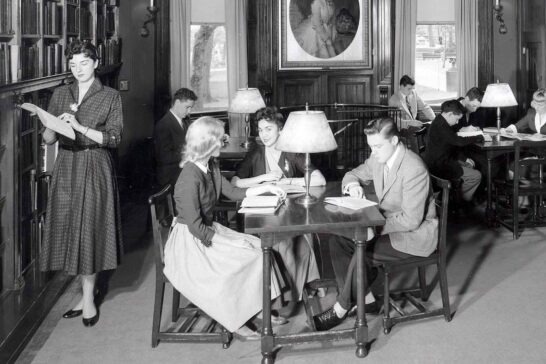Emma Griffin is a theater and opera director and managing artistic director of Mannes Opera at the New School’s College of Performing Arts. With a diverse background spanning theater, musical theater, and opera, her productions have been seen in performance venues all over the country, including collaborations on new music-theater works such as Ricky Ian Gordon and Frank Bidart’s operatic poem Ellen West (Beth Morrison Projects and Prototype), and Phil Kline’s Out Cold & Zippo Songs at BAM’s Next Wave Festival. She has directed for Opera Philadelphia, Boston Lyric Opera, Wolf Trap Opera, Juilliard Opera, and Atlanta Opera, among others, and was the Artistic Director of the OBIE-winning Salt Theater. As an educator, she has taught at New York University’s Tisch School of the Arts and SUNY Stony Brook, worked extensively at both Curtis and at Juilliard. Prior to her appointment to Mannes Opera, she spent four years as the professor of opera stage direction at the University of Cincinnati’s College-Conservatory of Music.
Interview with Emma Griffin, Director of Candide

Since 2006, Emma Griffin has directed eight productions at Curtis, including Sweeney Todd, Mahagonny/Medium, Wozzeck, I Capuleti e i Montecchi, The Rake’s Progress, Postcard from Morocco, The Cunning Little Vixen, and Die Zauberflöte. To learn more about her latest production with Curtis Opera Theatre, Leonard Bernstein’s (Conducting ’41) Candide, featuring rising stars of Curtis Opera Theatre and members of the Curtis Symphony Orchestra, under the baton of conductor David Charles Abell, click HERE.
How do you shape your vision while collaborating with designers and performers?
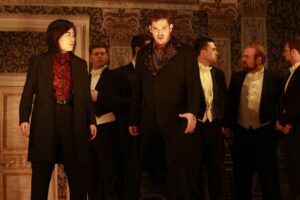 As a director, two things happen. The first is when someone comes to me with a project and says, “We want to do opera X.” The question for me then becomes: Do I respond to that work? Is that something I see my way into? If so, I can build a team around that.
As a director, two things happen. The first is when someone comes to me with a project and says, “We want to do opera X.” The question for me then becomes: Do I respond to that work? Is that something I see my way into? If so, I can build a team around that.
The second is that I, myself, have had a project kicking around in the back of my head, or I’ve just stumbled across it, and it feels thrilling and immediate and I move on that feeling and make it happen. In both situations, the instigating spark for me is, do I feel like I am in an intellectual and emotional relationship with the material? Is it something that I can work with? Can I be in conversation with it? Obviously, what I’m talking about is taste—does the material activate my taste and my understanding of how art works? Can it be in sustained conversations with my taste?
 And I will add that I don’t have to love it. Sometimes the work that I most love and revere is where I’m not sure that I have anything new to bring to the conversation. Whereas pieces where I feel friction, where I’m in tension with the material, that’s where I’m like, oh, I have something to say about this—I can make something from this friction. I’m not looking for an easy fit. Of course, there are exceptions—take an opera like The Cunning Little Vixen, with which I feel totally philosophically aligned, I’ve had great success with that one. But other times I’m attracted to the tension.
And I will add that I don’t have to love it. Sometimes the work that I most love and revere is where I’m not sure that I have anything new to bring to the conversation. Whereas pieces where I feel friction, where I’m in tension with the material, that’s where I’m like, oh, I have something to say about this—I can make something from this friction. I’m not looking for an easy fit. Of course, there are exceptions—take an opera like The Cunning Little Vixen, with which I feel totally philosophically aligned, I’ve had great success with that one. But other times I’m attracted to the tension.
And then you invite other artists to join the conversation. I’ve been a director for many decades, so I have lots of collaborators I love working with, but I’m also always looking for new voices. On any project, you want a group of people who are interested in the same questions, and who like to work in similar ways.
That gender inequity continues to be part of the conversation at this point in the 21st century is beyond disconcerting, but what steps can we continue to take to more effectively support and empower female, non-binary, and trans artists to lead and shape the future of opera?
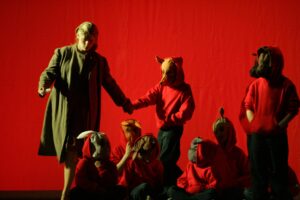 First, I want to say this: in every single interview I’ve done since I started directing in my early 20s, I’ve been asked some version of this question. When I talk to other women in the field—I think of a recent conversation with JoAnne Akalaitis (six-time OBIE Award-winning theater director and writer) who’s in her 80s; we talk about how we all get asked this question all the time. One wonders if anyone has been listening!
First, I want to say this: in every single interview I’ve done since I started directing in my early 20s, I’ve been asked some version of this question. When I talk to other women in the field—I think of a recent conversation with JoAnne Akalaitis (six-time OBIE Award-winning theater director and writer) who’s in her 80s; we talk about how we all get asked this question all the time. One wonders if anyone has been listening!
So, here’s what I’ll say, and the answer remains the same: female, non-binary, and trans artists need two things: 1.) they need to be in creative spaces where they are treated with honor and respect, where their presence and their voice is valued as central. 2.) They need to be properly paid.
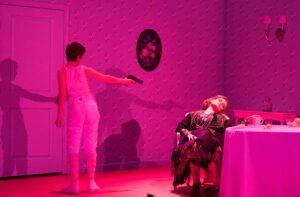 When I mentor younger women, trans artists, sometimes directors of color – I tell them this: The world wants to see you as a helper and not as a leader. They see your value as additive, and not central. This prevailing cultural mindset is a barrier impacting everything from proper credit to appropriate financial remuneration. You could be doing all the work, but your presence will be seen as being in service to “the work,” and not as “the work”.
When I mentor younger women, trans artists, sometimes directors of color – I tell them this: The world wants to see you as a helper and not as a leader. They see your value as additive, and not central. This prevailing cultural mindset is a barrier impacting everything from proper credit to appropriate financial remuneration. You could be doing all the work, but your presence will be seen as being in service to “the work,” and not as “the work”.
In our culture, power often equals money. I have been in situations where I have been paid less than my male peers, and it still happens. There is great reluctance to pay female, non-binary, and trans artists (also BIPOC artists) professional level fees. Again, it’s the narrative of who is central. White male artists are traditionally seen as bringing value to an institution and project, they are paid for adding value. Female/trans/BIPOC artists are seen as receiving value by the institution, and this is used as an excuse for paying them less.
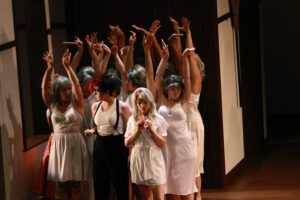 Add to all of this the vast importance and power of storytelling in defining what is valued and central to a culture. In the moment we are living through now, we are seeing a significant part of our society have a violent reaction to a big shift in our collective cultural story. There has been a shift in access to that centrality, to who can claim ownership of spaces and ideas and power. In an effort to soothe this intense reaction, many spaces will backtrack (they already are) and become even more exclusionary. Doors will be shut to control access to power. This backtracking is not a surprise, but it means more work for those most negatively impacted.
Add to all of this the vast importance and power of storytelling in defining what is valued and central to a culture. In the moment we are living through now, we are seeing a significant part of our society have a violent reaction to a big shift in our collective cultural story. There has been a shift in access to that centrality, to who can claim ownership of spaces and ideas and power. In an effort to soothe this intense reaction, many spaces will backtrack (they already are) and become even more exclusionary. Doors will be shut to control access to power. This backtracking is not a surprise, but it means more work for those most negatively impacted.
So the work continues. I think of our assistant on this show—Gabrielle Giacomo, a young director/choreographer of great talent and promise. I will continue to work very hard for the future I want for her. I hope that she—either by invitation or by her own making—has a future in rooms where she is valued and central storyteller, and where a respectful, appropriate payment for her excellent work is the norm. What a reasonable goal! And yet…
You’ve directed eight other productions here at Curtis and have institutional knowledge of the school that many don’t. What do you find most rewarding about working with the young artists of Curtis Opera Theatre?
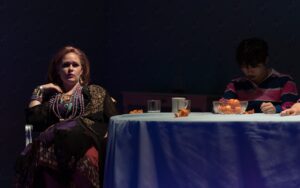 Curtis is so special to me because of my long relationship with the institution. It is the first place I directed an opera. I have learned so much, and I have been so beautifully mentored by the people here (I want to give a shout-out to the incredible coaches here—Lisa Keller taught me how to navigate an opera score on that very first show). From every single one of the operas you mentioned, I have deep friendships and professional relationships that have carried on through the years. Curtis has been a gift—I feel like I’ve done some of my best work here.
Curtis is so special to me because of my long relationship with the institution. It is the first place I directed an opera. I have learned so much, and I have been so beautifully mentored by the people here (I want to give a shout-out to the incredible coaches here—Lisa Keller taught me how to navigate an opera score on that very first show). From every single one of the operas you mentioned, I have deep friendships and professional relationships that have carried on through the years. Curtis has been a gift—I feel like I’ve done some of my best work here.
I have said this before, and I’ve said this at Mannes: I would not have the position I have at Mannes Opera without the time that I spent at Curtis. I’m just so grateful for the rigor and the artistic excellence here—what it taught me, and what I’ve learned from the students.
What was that first piece you directed at Curtis?
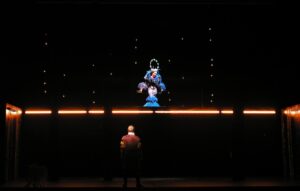 It was The Magic Flute—20 years ago! Mikael Eliasen brought me here, he thought I had something to offer. Mikael was—and continues to be—an extraordinary mentor to me, one of the most important people in my life. Flute was an incredibly rich experience where I realized, “Oh, I want to do this. This is amazing.” Actually, this summer I’m going to work with Jonathan Beyer (Opera ’07), who was one of the Papagenos in that production. It’s been such a special journey.
It was The Magic Flute—20 years ago! Mikael Eliasen brought me here, he thought I had something to offer. Mikael was—and continues to be—an extraordinary mentor to me, one of the most important people in my life. Flute was an incredibly rich experience where I realized, “Oh, I want to do this. This is amazing.” Actually, this summer I’m going to work with Jonathan Beyer (Opera ’07), who was one of the Papagenos in that production. It’s been such a special journey.
Curtis was a place where my artistic imagination and ambitions were met with a musical rigor and skill, and that was thrilling. I’m having the same experience now with Candide. The students are fantastic—interesting, curious, and alive as young artists. I’m excited to work with the orchestra! It’s just a joy to come back here.
Was that part of what attracted you take on Candide at Curtis?
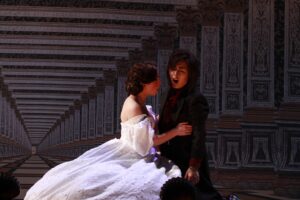 When Miloš [Repický, Director and Hirsig Family Chair of Vocal Studies and Opera] called, I was intrigued. The conductor [David Charles Abell] and I both work in musical theater within opera spaces, which is a very specific skill set. I’ve also done this with young artists, which is another specific skill set. So when Miloš reached out, I knew it was a good fit. Frankly, it’s an honor to be able to come back to Curtis—an institution that has been so important to my career in opera—during this particular year [the school’s centennial season]. It’s a pleasure.
When Miloš [Repický, Director and Hirsig Family Chair of Vocal Studies and Opera] called, I was intrigued. The conductor [David Charles Abell] and I both work in musical theater within opera spaces, which is a very specific skill set. I’ve also done this with young artists, which is another specific skill set. So when Miloš reached out, I knew it was a good fit. Frankly, it’s an honor to be able to come back to Curtis—an institution that has been so important to my career in opera—during this particular year [the school’s centennial season]. It’s a pleasure.
How has your perspective on the piece changed or evolved since you first mounted the production?
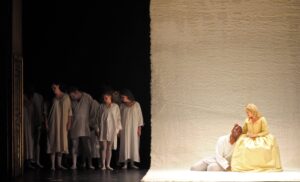 I understand why people keep returning to Candide. It’s trying to grapple with difficult questions through satire and frivolity—things I find deeply attractive. In preparation, I re-read all the different versions [there are seven published versions] and talked with David; we wrestled with all the issues of the piece that everyone wrestles with, trying to solve it in different ways.
I understand why people keep returning to Candide. It’s trying to grapple with difficult questions through satire and frivolity—things I find deeply attractive. In preparation, I re-read all the different versions [there are seven published versions] and talked with David; we wrestled with all the issues of the piece that everyone wrestles with, trying to solve it in different ways.
In these last months, especially now that we’re in the room, it really feels shockingly of the moment. Yesterday, we were working on “Auto-da-fé” (in Act I), and we had these singers essentially jazz-hands-ing their way through the sentiment “Let the foreigners burn.” It really feels like we are all the character of Candide right now. Lost in the chaos, reckoning with the realization that just trying to be a good person is not enough.
 Voltaire was pushing back against authoritarianism, against platitudes, against easy answers, and a flattening of reality. He was pushing back against social cruelty. Lillian Hellman [who wrote the original libretto of Candide] saw something in Voltaire that spoke to the reality of being an artist and an intellectual in post-WWII America. She is the one who brought it to Bernstein. Those tensions are still in the show. It’s about everyone trying to figure out how to live in a very hard time.
Voltaire was pushing back against authoritarianism, against platitudes, against easy answers, and a flattening of reality. He was pushing back against social cruelty. Lillian Hellman [who wrote the original libretto of Candide] saw something in Voltaire that spoke to the reality of being an artist and an intellectual in post-WWII America. She is the one who brought it to Bernstein. Those tensions are still in the show. It’s about everyone trying to figure out how to live in a very hard time.
Will there be contemporary references, and will this production tap into the current socio-political climate?
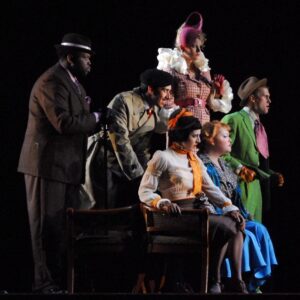 I am going to quote the visual artist James Turrell here: “All art is contemporary, because all art is happening right now.” We are doing Candide here in Philadelphia, in April 2025—the audience will take what they need from it. There is a lot to be said for meeting the current moment with satire and frivolity. In dark times, entertainment is a powerful force. That’s always been true.
I am going to quote the visual artist James Turrell here: “All art is contemporary, because all art is happening right now.” We are doing Candide here in Philadelphia, in April 2025—the audience will take what they need from it. There is a lot to be said for meeting the current moment with satire and frivolity. In dark times, entertainment is a powerful force. That’s always been true.
As you return to Candide, what do you find is the biggest challenge faced in maintaining a cohesive narrative and drawing out the absurdities of Voltaire’s satire to the stage?
It’s a huge show. It’s just huge. In all good satire, there’s always at least two things happening on stage that are in opposition to each other. So, you have to figure that out. There’s always tension on stage, and you have to balance the comedy and the music and the separate strands of storytelling.
Can you describe your vision for this production of Candide?
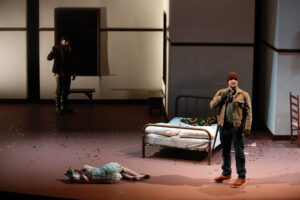 We are using the New York Philharmonic version of Candide—David and I both felt this was the best fit. Our production, although modern, is leaning hard on a type of vaudeville “Borscht Belt” comedy that was an important influence on the show when it was written, along with a modern sense of compression and storytelling.
We are using the New York Philharmonic version of Candide—David and I both felt this was the best fit. Our production, although modern, is leaning hard on a type of vaudeville “Borscht Belt” comedy that was an important influence on the show when it was written, along with a modern sense of compression and storytelling.
The entire cast is the narrator. It’s communal storytelling. And the character of Candide is sort of the innocent in the middle of the chaos, dropped into the world. They are all in this big room (it looks a little like an old Marx Brothers set), and everything, even a potted plant, is a tool for storytelling. There is a scrappy, vaudevillian ethos as the cast madly tries to navigate the event that is Candide. They themselves are a mash-up of stage people—folks who’ve wandered into this room off the sets and workrooms of other shows, other productions—a melting pot of artists. The stage is a liminal space, it’s backstage, a greenroom, a waiting room. It’s ordinary and mundane, but it’s made magical and alive by the performers.
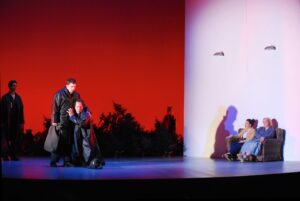 And there is dancing! I can’t talk about this show without talking about our choreographer Jeffrey Page—an Emmy Award-nominated choreographer who’s worked with everyone from Beyoncé to Mariah Carey, Jeanine Tesori, and Diane Paulus and is on the faculty at Harvard. Jeffery is one of my favorite people to work with—a great artist and a tremendous collaborator. I’m honored he’s here—we are so lucky! He’s a huge part of the life of the show, he’s given it movement and depth and vitality. And he’s got these incredible young artists up and dancing.
And there is dancing! I can’t talk about this show without talking about our choreographer Jeffrey Page—an Emmy Award-nominated choreographer who’s worked with everyone from Beyoncé to Mariah Carey, Jeanine Tesori, and Diane Paulus and is on the faculty at Harvard. Jeffery is one of my favorite people to work with—a great artist and a tremendous collaborator. I’m honored he’s here—we are so lucky! He’s a huge part of the life of the show, he’s given it movement and depth and vitality. And he’s got these incredible young artists up and dancing.
Overall, this production is a celebration of these incredible students—the singers on stage and instrumentalists in a pit—all of them doing an incredibly hard thing in a very sophisticated way, with music that is both joyful and complex but also pointed. It’s a satire about a time of great cruelty, and it’s not out of date. It’s a celebration of these young artists exercising their craft. They are telling us a story, they are entertaining us, and they have something to say.
Interview with Emma Griffin by Ryan Scott Lathan.
Visit Emma Griffin’s official website.
CURTIS OPERA THEATRE: CANDIDE
April 11, 2025 | Friday at 7:00 p.m.
April 13, 2025 | Sunday at 2:00 p.m.
The Forrest Theatre, 1114 Walnut St, Philadelphia
Click HERE for more information.
Portrait of Emma Griffin, courtesy of the artist. All photos of Emma Griffin’s productions with Curtis Opera Theatre by Mark Barton: 1 & 8.) I Capuleti e i Montecchi (2012). 2, 5, 10, 12.) The Cunning Little Vixen (2011). 3, 13.) Wozzeck (2009). 4, 6.) The Medium (2018). 7.) Die Zauberflöte (2006). 9.) The Rake’s Progress (2009). 11.) Postcard from Morocco (2007).
